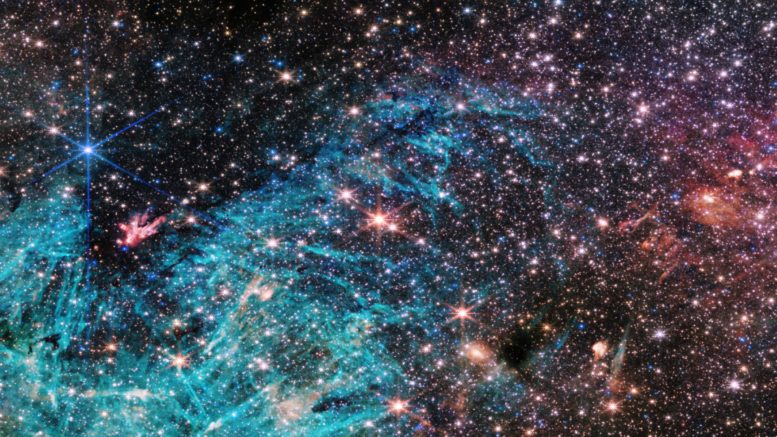The James Webb Space Telescope (JWST) has unveiled a breathtaking image showcasing a sprawling star factory located within a neighboring galaxy, featuring vibrant colors and intricate details. The mesmerizing orange, yellow, and blue hues in the image depict the interstellar atomic hydrogen of the N79 nebula, which spans an impressive 1,630 light-years. Situated in the Large Magellanic Cloud, a satellite galaxy of the Milky Way, N79 is actively engaged in the formation of stars and has largely remained unexplored by astronomers.
Considered a younger counterpart to another recent JWST target, the Tarantula Nebula, N79 has intrigued scientists due to its accelerated star-forming activity over the last 500,000 years. Researchers believe that N79 has been producing stars at a rate twice that of the Tarantula Nebula, officially known as 30 Doradus. The JWST’s focus on such intense star birth regions allows scientists to gain insights into the composition of gas and dust clouds during the early universe’s most prolific period of star formation.
The newly captured JWST image zeroes in on three significant complexes of cold atomic gas, collectively referred to as N79 South or S1. One striking feature in the image is the “starburst” pattern surrounding the bright center of N79, created by diffraction spikes resulting from the telescope’s primary mirror. The hexagonal arrangement of the 18 mirror segments generates six main diffraction spikes, particularly noticeable when observing bright and compact objects.
The JWST utilized its Mid-InfraRed Instrument (MIRI) to capture the N79 image, as long-wave infrared light can penetrate dense clouds of dust more effectively than visible light. This unique perspective enables astronomers to delve into the heart of this star-forming region and identify young stellar bodies still enveloped in their birth material. Termed “protostars,” these early-stage stars have yet to accumulate sufficient mass to initiate the fusion process that defines a star.
The JWST’s observations of N79 contribute to its broader mission, which includes examining the evolution of disks and envelopes surrounding stars at various stages of their lifecycle. Astronomers hope that the telescope will provide unprecedented views of planet-forming disks around young sun-like stars, offering valuable insights into the formation of our solar system approximately 4.6 billion years ago.

